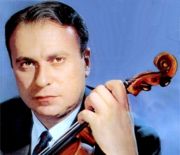Prominent Poles
Henryk Szeryng Polish-Jewish-Mexican violin virtuoso, teacher, diplomat, philanthropist,patron of the arts.

Born: September 22, 1918, Zelazowa Wola, Poland
Died: March 8, 1988, Kassel, Germany
Early days. His father was a wealthy industrialist and his mother had a great love of music. He started piano training when he was five but at 7 piano was abandoned for the violin, though Szeryng remained skilled at the keyboard for the rest of his life. Szeryng progressed quickly on his new instrument and by age nine was sufficiently proficient to perform the Mendelssohn concerto for famed violinist Bronislaw Hubermann, a friend of the family. On Hubermann's advice Szeryng was sent to Berlin to study with Carl Flesch; Szeryng would later declare that his technical prowess was solely due to that masterful teacher's influence. In 1933, Szeryng made his debut performance in Warsaw Philharminic with the Brahms concerto under Bruno Walter. That same year he embarked on a minor concert tour, soloing with orchestras in Bucharest, Vienna, and Paris.
Szeryng immediately settled in Paris for a period of further study and growth as a performer. There he came under the influence of violinists Enescu and Thibaud, studied at the Conservatory, and graduated with a “premier prix” in 1937. Szeryng also thought about pursuing composition as a career, and from 1933 to 1939 took lessons from Nadia Boulanger.
WWII. At the outbreak of World War II in 1939 Szeryng enlisted with the Polish army. He became official translator of the Polish prime minister General Wladyslaw Sikorski's government-in-exile in London (Szeryng was fluent in seven languages); later was made personal government liaison officer. In 1941 he accompanied the prime minister to Latin America to find a home for some 4,000 Polish refugees; the refugees were taken in by Mexico.
Professional career. His wartime association with Mexico and his appreciation of the country's acceptance of the refugees led to his return there after the war.. He was named director of the String Department at the National University of Mexico in 1945 and was granted Mexican citizenship shortly thereafter. Szeryng subsequently focused on teaching. In 1956 he was named Mexico's Cultural Ambassador of Good Will and enjoyed the title of ambassador for many years thereafter. In 1970 he was made Mexico's special adviser to UNESCO in Paris. His international concert career was revived in 1954, when Artur Rubinstein heard him play in Mexico and immediately contacted impresario Sol Hurok and other agents on Szeryng's behalf. In the years that followed, Szeryng performed in 65 countries on five continents.. Szeryng's accomplishments went far beyond those of a great violinist. is approach to music is acknowledged to be always thoughtful, unpretentious and full of respect for the composer. Possessing an iron technique and a musical intellect of rare insight, Szeryng established himself as one of the pre-eminent concert violinists of the post-World War II decades. He celebrated the 50th anniversary of his debut with a grand tour of Europe and the U.S. in 1983. A cosmopolitan fluent in 7 languages, a humanitarian, and a violinist of extraordinary gifts, Szeryng became renowned as a musician's musician by combining a virtuoso technique with a probing discernment of the highest order. Recordings of the Beethoven and Brahms sonatas with Artur Rubinstein are particularly rewarding. Of note also is Szeryng's world-premiere recording of Paganini's E major Violin Concerto No. 3, which Szeryng himself reconstructed from parts held in the archives of the legendary Italian violinist's heirs. In later years it is rumored that troubles with alcohol led to a somewhat deteriorated technical ability. He also composed; his works include a number of violin concertos and pieces of chamber music.
Awards. Grammy Award for Best Chamber Music Performance: 1975 Pierre Fournier, Arthur Rubinstein & Henryk Szeryng for Brahms: Trios (Complete)/Schumann: Trio No. 1 in D Minor ; 1976 Pierre Fournier, Arthur Rubinstein & Henryk Szeryng for Schubert: Trios Nos. 1 in B Flat, Op. 99 and 2 in E Flat, Op. 100 (Piano Trios)
Source:
This article uses, among others, material from the Wikipedia article "Henryk Szeryng" licensed under the GNU Free Documentation License. :
Wikipedia
with additions and modifications from:
Answers (includes Discography)
Legendary violinists
Library of Congree (C.J.Widgery)
Arkiv Music (DVDs)
New York Times obituary
Classical Virtuoso (several audios- Szeryng playing)
Return to home page:
Prominent Poles
